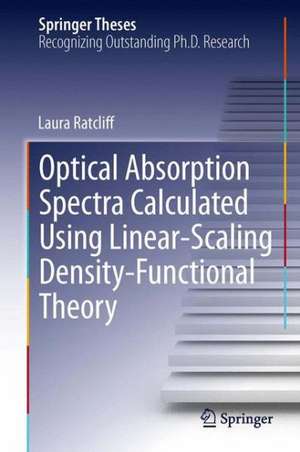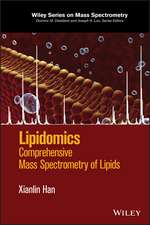Optical Absorption Spectra Calculated Using Linear-Scaling Density-Functional Theory: Springer Theses
Autor Laura Ratcliffen Limba Engleză Hardback – 3 iun 2013
| Toate formatele și edițiile | Preț | Express |
|---|---|---|
| Paperback (1) | 632.22 lei 6-8 săpt. | |
| Springer International Publishing – 15 iun 2015 | 632.22 lei 6-8 săpt. | |
| Hardback (1) | 637.13 lei 6-8 săpt. | |
| Springer International Publishing – 3 iun 2013 | 637.13 lei 6-8 săpt. |
Din seria Springer Theses
- 18%
 Preț: 997.88 lei
Preț: 997.88 lei -
 Preț: 389.88 lei
Preț: 389.88 lei - 15%
 Preț: 646.94 lei
Preț: 646.94 lei - 18%
 Preț: 943.43 lei
Preț: 943.43 lei -
 Preț: 399.29 lei
Preț: 399.29 lei - 18%
 Preț: 944.99 lei
Preț: 944.99 lei - 15%
 Preț: 636.80 lei
Preț: 636.80 lei - 18%
 Preț: 941.05 lei
Preț: 941.05 lei - 15%
 Preț: 643.16 lei
Preț: 643.16 lei - 15%
 Preț: 642.68 lei
Preț: 642.68 lei - 18%
 Preț: 1103.62 lei
Preț: 1103.62 lei - 20%
 Preț: 558.83 lei
Preț: 558.83 lei - 18%
 Preț: 1112.30 lei
Preț: 1112.30 lei - 18%
 Preț: 944.19 lei
Preț: 944.19 lei - 18%
 Preț: 1109.92 lei
Preț: 1109.92 lei - 18%
 Preț: 1217.27 lei
Preț: 1217.27 lei - 15%
 Preț: 640.06 lei
Preț: 640.06 lei - 15%
 Preț: 636.45 lei
Preț: 636.45 lei - 15%
 Preț: 640.06 lei
Preț: 640.06 lei - 15%
 Preț: 640.88 lei
Preț: 640.88 lei -
 Preț: 389.70 lei
Preț: 389.70 lei - 20%
 Preț: 563.91 lei
Preț: 563.91 lei -
 Preț: 393.35 lei
Preț: 393.35 lei - 15%
 Preț: 637.93 lei
Preț: 637.93 lei - 15%
 Preț: 641.85 lei
Preț: 641.85 lei - 18%
 Preț: 1225.94 lei
Preț: 1225.94 lei - 20%
 Preț: 551.36 lei
Preț: 551.36 lei - 18%
 Preț: 1229.10 lei
Preț: 1229.10 lei - 15%
 Preț: 639.25 lei
Preț: 639.25 lei - 18%
 Preț: 999.45 lei
Preț: 999.45 lei - 15%
 Preț: 640.06 lei
Preț: 640.06 lei - 18%
 Preț: 1220.45 lei
Preț: 1220.45 lei - 18%
 Preț: 1116.26 lei
Preț: 1116.26 lei - 18%
 Preț: 1110.72 lei
Preț: 1110.72 lei - 18%
 Preț: 1000.87 lei
Preț: 1000.87 lei - 18%
 Preț: 891.17 lei
Preț: 891.17 lei - 15%
 Preț: 640.06 lei
Preț: 640.06 lei - 5%
 Preț: 1154.07 lei
Preț: 1154.07 lei - 15%
 Preț: 635.96 lei
Preț: 635.96 lei - 15%
 Preț: 640.88 lei
Preț: 640.88 lei -
 Preț: 387.20 lei
Preț: 387.20 lei - 18%
 Preț: 1109.92 lei
Preț: 1109.92 lei -
 Preț: 385.25 lei
Preț: 385.25 lei -
 Preț: 385.25 lei
Preț: 385.25 lei - 18%
 Preț: 1112.30 lei
Preț: 1112.30 lei - 18%
 Preț: 999.45 lei
Preț: 999.45 lei -
 Preț: 386.99 lei
Preț: 386.99 lei - 15%
 Preț: 637.13 lei
Preț: 637.13 lei - 20%
 Preț: 554.21 lei
Preț: 554.21 lei - 20%
 Preț: 555.59 lei
Preț: 555.59 lei
Preț: 637.13 lei
Preț vechi: 749.56 lei
-15% Nou
Puncte Express: 956
Preț estimativ în valută:
121.92€ • 130.37$ • 101.65£
121.92€ • 130.37$ • 101.65£
Carte tipărită la comandă
Livrare economică 18 aprilie-02 mai
Preluare comenzi: 021 569.72.76
Specificații
ISBN-13: 9783319003382
ISBN-10: 3319003380
Pagini: 128
Ilustrații: XI, 116 p.
Dimensiuni: 155 x 235 x 13 mm
Greutate: 0.33 kg
Ediția:2013
Editura: Springer International Publishing
Colecția Springer
Seria Springer Theses
Locul publicării:Cham, Switzerland
ISBN-10: 3319003380
Pagini: 128
Ilustrații: XI, 116 p.
Dimensiuni: 155 x 235 x 13 mm
Greutate: 0.33 kg
Ediția:2013
Editura: Springer International Publishing
Colecția Springer
Seria Springer Theses
Locul publicării:Cham, Switzerland
Public țintă
ResearchCuprins
Density Functional Theory.- Linear-Scaling Methods.- Theoretical Spectroscopy.- Basis Sets and Band Structures.- Conduction States: Methods and Applications.- Results and Discussion.
Textul de pe ultima copertă
The development of linear-scaling density functional theory (LS-DFT) has made ab initio calculations on systems containing thousands of atoms possible. These systems range from nanostructures to biomolecules. These methods rely on the use of localized basis sets, which are optimised for the representation of occupied Kohn-Sham states but do not guarantee an accurate representation of the unoccupied states. This is problematic if one wishes to combine the power of LS-DFT with that of theoretical spectroscopy, which provides a direct link between simulation and experiment. In this work a new method is presented for optimizing localized functions to accurately represent the unoccupied states, thus allowing theoretical spectroscopy of large systems. Results are presented for optical absorption spectra calculated using the ONETEP code, but the method is equally applicable to other spectroscopies and LS formulations. Other topics covered include a study of some simple one dimensional basis sets and the presentation of two methods for band structure calculation using localized basis sets, both of which have important implications for the use of localized basis sets within LS-DFT.
Caracteristici
Nominated as an outstanding Ph.D. thesis by Imperial College London Awarded the Thomas Young Centre Imperial prize for 'the most important and innovative contribution to research in the theory and simulation of materials' Describes a method for optimizing localized basis functions to accurately represent unoccupied states Combines linear-scaling density-functional theory with theoretical spectroscopy to allow ab initio spectroscopy calculations of very large systems








